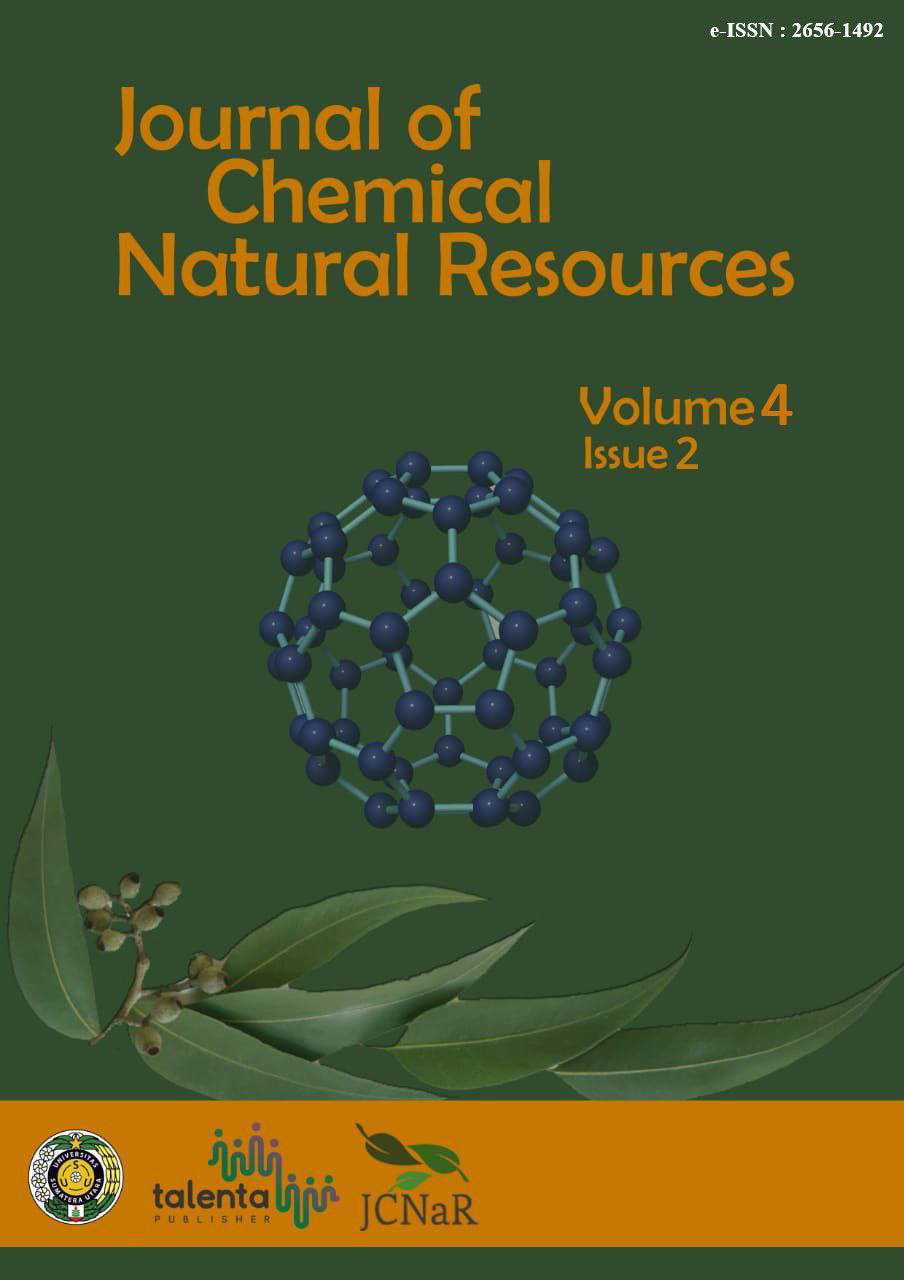Fabrication of Bioethanol via Fermentation from Cellulose of Kepok Banana (Musa Paradisiaca L.) Using Bread's Yeast (Saccharomyces cerevisiae)
DOI:
https://doi.org/10.32734/jcnar.v4i2.11964Keywords:
Adsorbent, Antioxidant, Calcium Silicate, Candlenut Oil, Vitamin E.Abstract
Bioethanol has been made by fermentation of the cellulose of Kepok banana stems, where this study went through 3 stages. First-stage isolation of cellulose from Kepok banana prevents using HNO3 and NaNO2, removal of swelling with NaOH and Na2SO3, and bleaching process (bleaching) using NaOCl and H2O2, then functional group analysis was performed with FT-IR. The second stage of cellulose obtained was hydrolysed with 1% HCl for 120 minutes of hydrolysis time. The resulting glucose was analysed by Benedict's reagent and the Luff-Schrool method. The third stage of glucose solution results from fermented hydrolysis using bread yeast (Saccharomyces cerevisiae) with variations in the weight of yeast 5, 6, and 7 grams, and the duration of fermentation is five days. Bioethanol obtained was tested qualitatively using K2CrO7 and H2SO4 reagents and bioethanol characterisation using GC. The study results obtained 10.18% glucose levels, and the highest levels of bioethanol were obtained at 11.27% with 88.53% purity using 7 g of yeast.
Downloads
References
Alemdar, A., and Sain, M., 2008. Isolation and Characterisation of Nanofibers From Agricultural Residue-Wheat Straw and Soy Hulls. Bioresources and Technology. 99: 1664-1671
Almatsier, S, 2004. Basic Principles of Nutrition Science. PT. Gramedia General Library. Jakarta
Azhar, SHM, 2017. Yeast in sustainable bioethanol production: A review. Malaysia: Elsevier BV
Fessenden. J., 1982. Organic Chemistry. Erlangga. Jakarta.
Khodijah, S. 2015. Analysis of the Effect of Variation in Percentage of Yeast ( Saccharomyces Cerevisiae ) and Time in the Fermentation Process in Utilising Duckweed ( Lenma Minor ) as Bioethanol. Malang: UIN Maliki Malang
Komarayati S and Gusmailina, 2010. Prospects for Bioethanol as a Substitute for Kerosene. Center for Research and Development of Forest Products. Bogor
Moeksin, R et al. 2010. Production of Ethanol from Jicama with Variations in Yeast Weight, Time, and Type of Yeast Vol. 17 No. 2
Ohwoavworhua, F. 2009. Processing Pharmaceutical Grade Microcrystalline Cellulose From Groundnut Husk: Extraction Methods And Characterisation. International Journal of Green Pharmacy.
Pescok, RL, Shields, LD, Caims, T. and McWilliam, IG 1976. Modern Methods of Chemical Analysis. New York: Wiley.
Sari, L., 2012. Effect of Fermentation Time and Weight of Baker's Yeast on Bioethanol Levels from the Glucose Fermentation Process of Hydrolysed Rice Straw Cellulose with 30% HCl. [Thesis] Medan: University of North Sumatra.
Satuhu and Supriyadi. 2008. Bananas: Cultivation, Processing, and Market Prospects. Self-help Spreader. Jakarta.
Shokrkar Hanieh, Sirous Ebrahimi, Mehdi Zamani., 2018. Enzymatic hydrolysis of microalgal cellulose for bioethanol production, modelling, and sensitivity analysis. Iran: Ellvesiern. Ltd
Suri, A., 2012. Effect of Fermentation Time and Weight of Baker's Yeast on Bioethanol Levels from Glucose Fermentation from Hydrolyzed Cellulose Empty Fruit Bunches of Oil Palm (Elaeis Guineensis Jack) with 30% HCl. [Thesis] Medan: University of North Sumatra.
Susanto, F., 2012. Effect of Baker's Yeast Addition and Fermentation Time on Glucose Hydrolyzed Sugarcane Bagasse Cellulose (Saccharum Officanarum) with 30% HCl in Bioethanol Production [Thesis]. Medan: University of North Sumatra
Winarno, FG 1995. Food Chemistry and Nutrition. Main Library Gramedia. Jakarta.

Downloads
Published
Issue
Section
License
Copyright (c) 2023 Journal of Chemical Natural Resources

This work is licensed under a Creative Commons Attribution-ShareAlike 4.0 International License.














